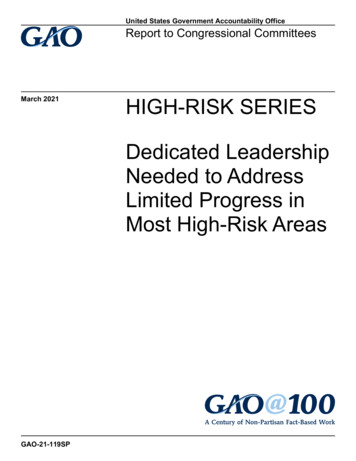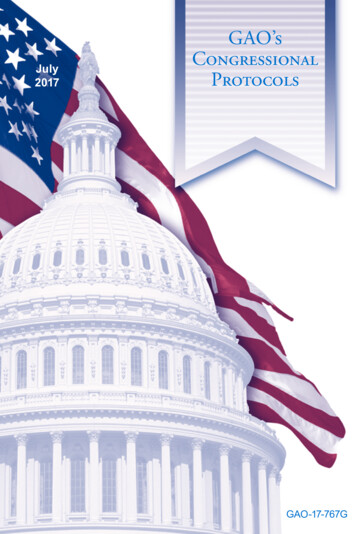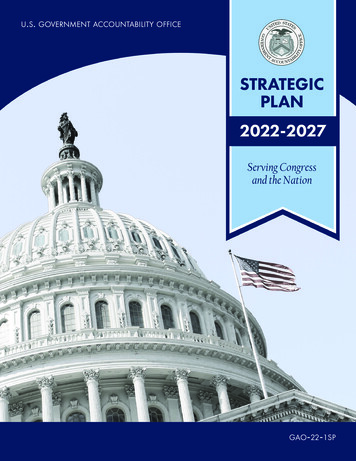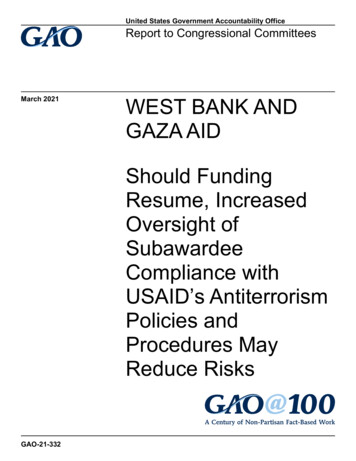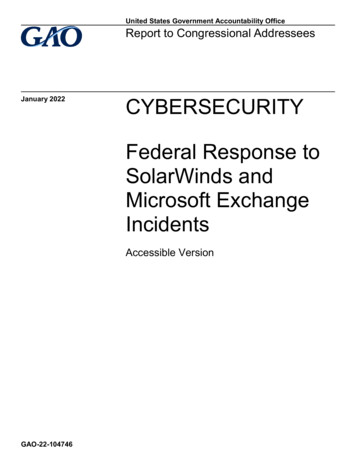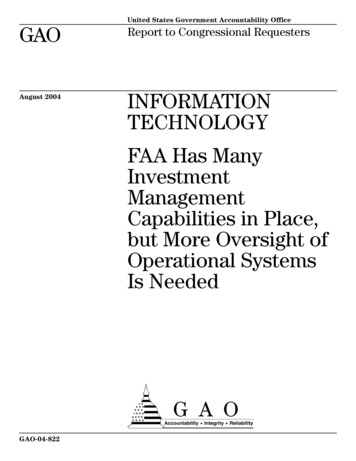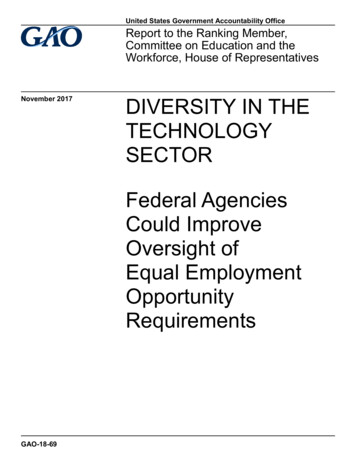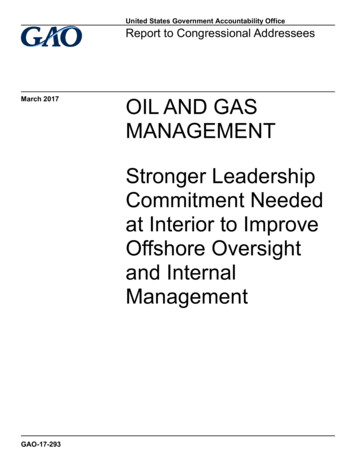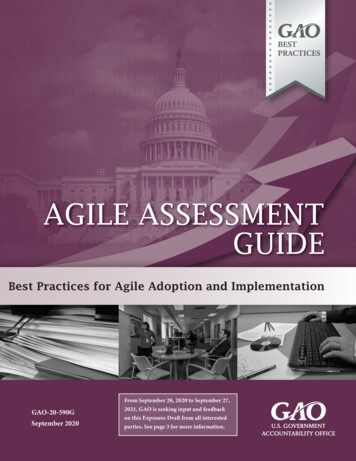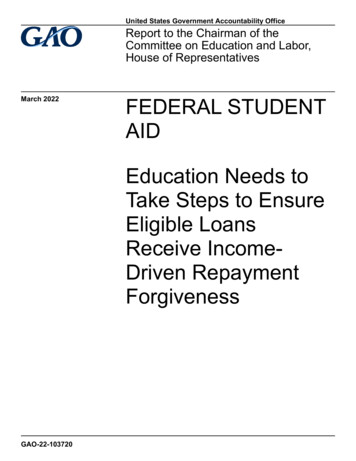
Transcription
United States Government Accountability OfficeReport to the Chairman of theCommittee on Education and Labor,House of RepresentativesMarch 2022FEDERAL STUDENTAIDEducation Needs toTake Steps to EnsureEligible LoansReceive IncomeDriven RepaymentForgivenessGAO-22-103720
March 2022FEDERAL STUDENT AIDHighlights of GAO-22-103720, a report to theChairman of the Committee on Education andLabor, House of RepresentativesEducation Needs to Take Steps to Ensure EligibleLoans Receive Income-Driven RepaymentForgivenessWhy GAO Did This StudyWhat GAO FoundAbout half of the more than 1 trillion inoutstanding federal student DirectLoans are being repaid by borrowersusing IDR plans. Some borrowers inIDR plans are now potentially eligiblefor forgiveness of their remaining loanbalances after 20 or 25 years ofpayments. GAO was asked to reviewIDR forgiveness.The Department of Education approved forgiveness for a total of 157 loans underIncome-Driven Repayment (IDR) plans as of June 1, 2021, but has not taken thesteps necessary to ensure that all eligible loans receive IDR forgiveness. IDRplans generally lower monthly payment amounts and extend repayment to 20 or25 years of qualifying payments, after which borrowers become eligible forforgiveness of their remaining loan balances without needing to apply. However,GAO found that about 7,700 loans in repayment (about 11 percent of loansanalyzed) could be potentially eligible for IDR forgiveness. Education’srepayment data do not provide enough information to definitively determine whythese loans—totaling about 49 million in outstanding debt—had not beenforgiven as of September 1, 2020 (see figure). Education officials said datalimitations make it difficult to track some qualifying payments and older loans areat higher risk for payment tracking errors. Until Education takes steps to addresssuch errors, some borrowers may not receive the IDR forgiveness they areentitled. This risk will increase as Education data show loans potentially eligiblefor IDR forgiveness will climb to about 1.5 million loans by 2030.This report examines (1) how manyloans have received IDR forgivenessand the extent to which Educationensures eligible loans receiveforgiveness, and (2) the extent towhich Education provides keyinformation about IDR forgiveness toborrowers in IDR plans.GAO analyzed Education data on IDRloans that had been in repayment longenough to be potentially eligible forIDR forgiveness as of September 1,2020, and data on loans forgiven as ofJune 1, 2021, the most recent dataavailable. In addition, GAO interviewedEducation and loan servicer officials,and reviewed documents from all nineservicers operating in 2020, Educationrequirements, and relevant federallaws and regulations.What GAO RecommendsGAO is making five recommendationsto Education, including that Educationtake steps to identify and addresspayment tracking errors, and ensureborrowers receive additionalinformation about requirements forforgiveness and counts of qualifyingpayments. Education agreed withGAO’s recommendations.View GAO-22-103720. For more information,contact Melissa Emrey-Arras at (617) 7880534 or emreyarrasm@gao.gov.Selected Outcomes for Loans in Repayment Long Enough to be Potentially Eligible forIncome-Driven Repayment ForgivenessGAO identified gaps in the information Education and its loan servicers provide toborrowers about IDR forgiveness. Education does not provide information about the requirements for receivingIDR forgiveness, including what counts as a qualifying payment towardforgiveness, in key communications to IDR borrowers. Borrowers who do notreceive this information may be unaware that months in forbearance andmost types of deferment generally do not count. Additional information wouldhelp borrowers understand requirements for forgiveness.Education and its servicers told GAO they do not provide regular updates toborrowers in IDR plans on the counts of qualifying payments made towardforgiveness unless borrowers request them. They also do not notify allborrowers about options to request and verify these counts. Providing thisinformation is especially important given the risk of payment tracking errors.Unless Education ensures borrowers are better informed about forgivenessrequirements and qualifying payment counts, IDR borrowers may makeuninformed decisions and be unable to correct inaccurate counts, potentiallydelaying forgiveness.United States Government Accountability Office
ContentsLetter1BackgroundFew Loans Have Received IDR Forgiveness and Education’sProcedures Risk Delayed or Missed ForgivenessEducation’s Key Communications with Borrowers Omit ImportantInformation about IDR Loan ForgivenessConclusionsRecommendations for Executive ActionAgency Comments and Our Evaluation417222324Appendix IObjectives, Scope, and Methodology26Appendix IIComments from the Department of Education33Appendix IIIGAO Contact and Staff Acknowledgments3710TableTable 1: Types of Income-Driven Repayment (IDR) Plans forFederal Student Loans5FiguresFigure 1: Examples of Length of Time in Repayment forHypothetical Student Loan Borrowers on Income-DrivenRepayment Plans with a 25-year Repayment PeriodFigure 2: Selected Outcomes for Loans in Repayment LongEnough to be Potentially Eligible for Income-DrivenRepayment ForgivenessFigure 3: Student Loans in Repayment Long Enough to PotentiallyQualify for Income-Driven Repayment (IDR) Forgiveness,as of September 1 in 2021-2030Page i81116GAO-22-103720 Income-Driven Repayment Forgiveness
AbbreviationsDirect LoanEducationFFELIDRNSLDSWilliam D. Ford Federal Direct LoanDepartment of EducationFederal Family Education LoanIncome-Driven RepaymentNational Student Loan Data SystemThis is a work of the U.S. government and is not subject to copyright protection in theUnited States. The published product may be reproduced and distributed in its entiretywithout further permission from GAO. However, because this work may containcopyrighted images or other material, permission from the copyright holder may benecessary if you wish to reproduce this material separately.Page iiGAO-22-103720 Income-Driven Repayment Forgiveness
Letter441 G St. N.W.Washington, DC 20548March 21, 2022The Honorable Robert C. “Bobby” ScottChairmanCommittee on Education and LaborHouse of RepresentativesDear Mr. Chairman:Repaying federal student loans can be challenging for borrowers,particularly those with lower incomes. As of September 2021, about halfof the approximately 1 trillion in outstanding William D. Ford FederalDirect Loans (Direct Loan) was being repaid by borrowers using IncomeDriven Repayment (IDR) plans that are designed to make payments moreaffordable. IDR plans base monthly payment amounts on a borrower’sincome and family size, extend repayment periods from the standard 10years to 20 or 25 years, and forgive any loan balances remaining at theend of the repayment period. Since loan payments made as early as1994 may count toward IDR forgiveness, some loans are now eligible tohave their remaining balances forgiven. 1Borrowers qualify for IDR forgiveness by accruing 20 or 25 years ofqualifying payments, which can include scheduled monthly payments aslow as 0. 2 The Department of Education and its contracted loanservicers are responsible for tracking progress toward IDR forgivenessand Education is responsible for providing forgiveness when it is due.However, little is known about how Education ensures that eligible loansreceive IDR forgiveness. You asked us to review Education’sadministration of IDR loan forgiveness.This report examines (1) how many loans have received IDR forgivenessand the extent to which Education ensures eligible loans receiveforgiveness, and (2) the extent to which Education provides key1TheDepartment of Education implemented the first IDR plan in 1994 and since that timehas introduced additional IDR plans, some of which also allow for certain payments madeas early as 1994 to qualify toward IDR forgiveness.2Therepayment period for IDR plans is up to 20 or 25 years, depending on the plan.Scheduled monthly payments for borrowers enrolled in IDR plans are calculated based onborrower income and family size and can be as low as 0 for some borrowers. Scheduledmonthly payments of 0 count as qualifying payments towards forgiveness on IDR plans.Page 1GAO-22-103720 Income-Driven Repayment Forgiveness
information about IDR loan forgiveness to borrowers enrolled in IDRplans.To address the first objective, we analyzed data from Education’sNational Student Loan Data System (NSLDS) to identify the status andcharacteristics of Direct Loans in IDR plans that had been in repaymentlong enough to potentially be eligible for IDR forgiveness as of September1, 2020, the most recent data at the time of our analysis. 3 For loans withinthis population that were in repayment as of September 1, 2020, we alsoanalyzed loan history information to gain insights about why the loans hadnot received forgiveness. Specifically, we used available loan history datato calculate how many months the loans spent in statuses that do notcount toward IDR forgiveness, including forbearance prior to March 2020,default, delinquency, or deferments other than economic hardshipdeferments. 4 We also obtained updated data from Education about theloans that had been approved for IDR forgiveness as of June 1, 2021,including the date the loans were forgiven and the amount forgiven. 5 Inaddition, we analyzed NSLDS data to identify IDR loans that had been inrepayment long enough to potentially become eligible for IDR forgivenessbetween September 1, 2020 and September 1, 2030.3Weused the date the loan first entered statutory repayment to identify loans that hadbeen in repayment long enough to potentially be eligible for IDR forgiveness. Our analysisdid not include loans under the Federal Family Education Loan (FFEL) program becausethese loans have different requirements for IDR forgiveness and would not be eligibleduring the period of our analysis.4Inresponse to the COVID-19 pandemic, on March 27, 2020, the CARES Act wasenacted, which suspended federal student loan payments due, interest accrual, andinvoluntary collections for most student loans through September 30, 2020, and providedthat these months without payments also count as qualifying payments for the purpose offederal student loan rehabilitation and forgiveness programs, including IDR forgiveness.Pub. L. No. 116-136, § 3513, 134 Stat. 281, 404-05 (2020). Education implemented thisCOVID-19 emergency relief for federal student loans retroactively to March 13, 2020, thedate COVID-19 was declared a national emergency. This relief has been extendedseveral times through administrative actions, and has most recently been extended untilMay 1, 2022.5Weobtained updated data from Education to provide a more current snapshot on thenumber of loans approved for IDR forgiveness and to account for potential lags betweenwhen IDR forgiveness is approved and when it is recorded in NSLDS. We adjusted ouranalysis to account for additional loans that received IDR forgiveness since we receivedthe original dataset from Education. Specifically, we ensured that all loans that receivedforgiveness through June 1, 2021, were included in the total number of loans approved forIDR forgiveness and these loans are not captured in any other category.Page 2GAO-22-103720 Income-Driven Repayment Forgiveness
We assessed the reliability of Education’s data by reviewing relateddocuments, interviewing knowledgeable officials responsible for eachdataset, and performing electronic tests on specific data elements. On thebasis of our reliability assessment results, we determined that theEducation data we used in our analysis were sufficiently reliable for ourpurposes of reporting the numbers and characteristics of IDR loans thathave been in repayment long enough to be potentially eligible for IDRforgiveness by September 1, 2030.To address our second objective, we obtained examples ofcommunication documents provided to borrowers at multiple stages ofIDR repayment from all nine servicers operating in 2020. 6 For each ofthese example communications, we determined the extent to which theyincluded key information about IDR forgiveness requirements, such asthe repayment terms and what qualifies as a payment toward IDRforgiveness.For both objectives, we reviewed Education documents such assummaries of requirements for student loan servicers, procedures forprocessing data, and monitoring reports. We also interviewed Educationofficials from Federal Student Aid, the office responsible for developingpolicies and procedures for administering IDR plans and overseeing howloan servicers implement them. In addition, we conducted semi-structuredinterviews with officials at four servicers and collected and analyzedwritten responses and documentation from all nine servicers that wereservicing Direct Loans in 2020 about their procedures for trackingqualifying payments, obtaining and verifying the accuracy of related datafrom previous servicers, and communicating with borrowers. 7 Weevaluated the information we obtained using criteria from Education’sFederal Student Aid Fiscal Year 2020-2024 strategic plan and federal6Thefour largest servicers as of 2020 were Great Lakes, Navient, Nelnet, and thePennsylvania Higher Education Assistance Agency. The remaining five loan servicerswere CornerStone, EdFinancial, Granite State, Missouri Higher Education Loan Authority,and Oklahoma Student Loan Authority Servicing. However, CornerStone’s contract withEducation ended in October 2020 and Navient’s contract was transferred to a newservicer in October 2021. The contracts for Granite State and the Pennsylvania HigherEducation Assistance Agency are expected to end in March 2022 and December 2022,respectively.7Whenreporting on these written responses from the nine servicers, we use the term“several” when describing cases in which three to six servicers provided similarresponses.Page 3GAO-22-103720 Income-Driven Repayment Forgiveness
internal control standards. 8 We also reviewed relevant federal laws andregulations. For more information about our objectives, scope, andmethodology, see appendix I.We conducted this performance audit from August 2019 to March 2022 inaccordance with generally accepted government auditing standards.Those standards require that we plan and perform the audit to obtainsufficient, appropriate evidence to provide a reasonable basis for ourfindings and conclusions based on our audit objectives. We believe thatthe evidence obtained provides a reasonable basis for our findings andconclusions based on our audit objectives.BackgroundThe Direct Loan program provides financial assistance to students andtheir parents to help pay for postsecondary education. A variety ofrepayment plans are available to eligible Direct Loan borrowers, includingStandard, Graduated, Extended, and several IDR plans. Borrowers areautomatically enrolled in the Standard plan if they do not choose anotheroption and they generally make fixed monthly payments over a period of10 years. 9 However, borrowers can generally change repayment plans atany time. IDR plans can ease the repayment burden by setting monthlyloan payments based on a borrower’s income and family size andextending the repayment period up to 20 or 25 years, depending on theplan. Unlike Standard, Graduated, and Extended repayment plans, whichrequire the loan to be repaid in full, IDR plans offer forgiveness of theloan’s balance at the end of the repayment period and monthly paymentsmay be as low as 0 for some borrowers.There are currently five IDR plans for federal student loans, which vary interms of eligibility requirements, how monthly payments are calculated,8U.S.Department of Education, Federal Student Aid, Federal Student Aid: Strategic Plan,Fiscal Years 2020-2024, (Washington D.C.: December 2020) and GAO, Standards forInternal Control in the Federal Government, GAO-14-704G (Washington D.C.: September2014). Specifically, we used standards related to managing risk and using qualityinformation for the first objective and communication for the second objective.9Termsfor other repayment plans vary, depending on the type of loan and when the loanentered repayment. Under the Graduated plan, for loans entering repayment on or afterJuly 1, 2006, borrowers have a fixed repayment term of up to 10 years (or 10 to 30 yearsfor Consolidation loans) and monthly payments gradually increase over time. Under theExtended plan, for loans entering repayment on or after July 1, 2006, borrowers’ terms arefixed at 25 years or less. Monthly payments under this plan may be fixed or graduated,and borrowers must have more than 30,000 in loans to qualify. Monthly paymentamounts under the Standard, Graduated, and Extended repayment plans are not basedon income.Page 4GAO-22-103720 Income-Driven Repayment Forgiveness
and the required number of qualifying payments borrowers must makebefore any remaining loan balances may be forgiven (see table 1).Generally, outstanding student loan balances forgiven through IDRforgiveness are subject to federal taxation. However, the AmericanRescue Plan Act of 2021 enacted in March 2021 temporarily excludedmost student loan forgiveness, including IDR forgiveness, received in2021 through 2025 from gross income for purposes of federal taxation. 10Table 1: Types of Income-Driven Repayment (IDR) Plans for Federal Student LoansMonthly paymentamountfRepayment periodbefore potential loanforgiveness (in years)Earliest possibleforgiveness datefor Direct LoansIDR PlanEligibilityaIncome-ContingentRepaymentAll Direct Loan borrowersGenerally 20 percent ofborrower’s discretionaryincomeg25July 2019Income-BasedRepaymentIncome-eligibleb borrowers whoreceived Direct Loan or FederalFamily Education Loan (FFEL)before July 1, 2014c15 percent of borrower’sdiscretionary incomeh25July 2019New Income-BasedRepaymentIncome-eligibleb borrowers who 10 percent of borrower’sreceived Direct Loans on or after discretionary incomehJuly 1, 2014d20July 2034Pay As You EarnIncome-eligibleb borrowers who 10 percent of borrower’sreceived Direct Loans on or after discretionary incomehOctober 1, 2007e20October 2027Revised Pay As You All Direct Loan borrowersEarn10 percent of borrower’sdiscretionary income20 (if all loans being repaid December 2015were received for(undergraduate)undergraduate study)July 2019 (graduate)25 (if any loans beingrepaid were received forgraduate or professionalstudy)Source: GAO analysis of U.S. Department of Education information. GAO-22-103720aDefaulted loans are ineligible for IDR plans unless a borrower rehabilitated the loan and re-enters aqualifying repayment status. In general, default occurs when a borrower reaches 270 days ofdelinquency (failure to make a payment when due). In addition, PLUS loans made to parents ofdependent undergraduates (Parent PLUS loans) are ineligible for IDR plans; however, Parent PLUSborrowers who consolidated their loans on or after July 1, 2006, are eligible for the IncomeContingent Repayment plan.bBorrowers are eligible if their Standard 10-year repayment amount exceeds their repayment amountunder the plan.Income-Based Repayment is the only IDR plan for which a FFEL loan may be eligible without firstbeing consolidated into a Direct Consolidation Loan. For FFEL loans in Income-Based Repaymentplans, the first allowable date for making a qualifying payment was July 1, 2009. Therefore, the firstpossible date for a FFEL loan to be granted IDR forgiveness would be 2034.c10Pub.Page 5L. No. 117-2, § 9675, 135 Stat. 4, 185-86.GAO-22-103720 Income-Driven Repayment Forgiveness
dThe New Income-Based Repayment plan is only available to new borrowers on or after July 1, 2014.For this plan, new borrowers are defined as individuals who had no outstanding federal student loanbalance when they received a Direct Loan on or after July 1, 2014. Borrowers who do not meet thisdefinition may be eligible for the Income-Based Repayment plan, but not the New Income-BasedRepayment plan.eThe Pay As You Earn plan is only available to borrowers who (1) are new borrowers on or afterOctober 1, 2007, defined as individuals who had no outstanding federal student loan balance whenthey received a Direct or FFEL loan on or after October 1, 2007; and (2) received a disbursement of aDirect Loan on or after October 1, 2011.Monthly payments for IDR plans are generally set as a proportion of the borrower’s discretionaryincome, which Education defines as adjusted gross income that exceeds 100 percent of theapplicable federal poverty guideline for the Income-Contingent Repayment plan, and 150 percent ofthe applicable guideline for all other IDR plans. Poverty guidelines are published annually by theDepartment of Health and Human Services and vary based on geographic location and family size.Adjusted gross income is the adjusted gross income as reported to the Internal Revenue Service, andconsists of gross income, including income from employment, unemployment compensation,dividends, interest, tips, and alimony received, minus certain deductions, such as certain retirementcontributions, and moving and education expenses. For most plans, except Revised Pay As YouEarn, when determining payment amounts, spousal income is considered only for borrowers whojointly file a federal tax return with their spouse.fgBorrowers pay the lesser of (a) 20 percent of discretionary income, or (b) the amount the borrowerwould pay over 12 years with fixed payments multiplied by an income percentage factor that is setand annually adjusted by Education.hMonthly payment amounts are capped at less than or equal to the monthly payment amount underthe Standard 10-year repayment plan.In certain scenarios, borrowers may change from one IDR plan to anotherduring the life of their loan. For example, Education reported that someborrowers have changed from the Income-Contingent Repayment planthat requires 25 years of qualifying payments to the newer Revised PayAs You Earn plan. That plan requires 20 years of qualifying payments forborrowers with only undergraduate loans, and it may lower monthlypayment amounts.Qualifying Paymentstoward IDR ForgivenessMonthly payments made under any of the IDR plans or the 10-yearStandard repayment plan generally count as qualifying payments towardforgiveness, as do months in which a borrower has been granted aneconomic hardship deferment on eligible loans. 11 This includes periodswhen the loan’s scheduled monthly IDR plan payment is 0. In addition,under the CARES Act and related administrative actions due to theCOVID-19 pandemic, most student loans were placed in forbearance11Eligible borrowers may temporarily postpone loan payments through deferment. Severaldifferent types of deferment are available to borrowers, each with its own eligibility criteria.Borrowers may qualify for an economic hardship deferment if they meet certain eligibilityrequirements such as having income below a certain level or qualifying for other meanstested benefits such as Temporary Assistance for Needy Families. Payments made underGraduated or Extended repayment plans may qualify if the required payment amount is atleast as high as the loan payment would have been under the Standard repayment plan.Page 6GAO-22-103720 Income-Driven Repayment Forgiveness
beginning March 13, 2020, with a planned end date of May 1, 2022.Unlike other periods of forbearance, interest does not accrue on theloans, and the months without payments count as qualifying paymentstoward IDR forgiveness. 12The actual length of a loan’s repayment period and the timing offorgiveness can vary based on the requirements of the specific IDR planand the circumstances and repayment history of the borrower (see fig. 1).Loans in IDR plans may complete repayment before they are eligible forforgiveness if, for example, their scheduled monthly payments are highenough to repay the total balance earlier. It may also take longer than 20to 25 years for a loan to be eligible for forgiveness if the loan spends anymonths in delinquency or is in the following statuses that do not generallycount as qualifying payments: payments made in a non-qualifying repayment plan, deferment other than economic hardship deferment, forbearance, or default. 13In addition, loans that are consolidated must restart the process ofaccruing qualifying months toward IDR forgiveness.12OnMarch 27, 2020, the CARES Act was enacted, which suspended student loanpayments due, interest accrual, and involuntary collections for most federal student loansthrough September 30, 2020, and provided that these months without payments alsocount as qualifying payments for the purpose of federal student loan rehabilitation andforgiveness programs, including IDR forgiveness. Pub. L. No. 116-136, § 3513, 134 Stat.at 404-05. Education implemented this COVID-19 emergency relief for federal studentloans retroactively to March 13, 2020, the date COVID-19 was declared a nationalemergency. This relief been extended several times through administrative actions, andhas most recently been extended until May 1, 2022.13Eligible borrowers can temporarily postpone or reduce loan payments throughforbearance. With the exception of COVID-19-related forbearance, interest on the loangenerally continues to accrue during forbearance. In general, default occurs when aborrower reaches 270 days of delinquency (failure to make a payment when due).Page 7GAO-22-103720 Income-Driven Repayment Forgiveness
Figure 1: Examples of Length of Time in Repayment for Hypothetical Student Loan Borrowers on Income-Driven RepaymentPlans with a 25-year Repayment PeriodNote: These examples all assume that the borrower was enrolled in an Income-Driven Repaymentplan that required 25 years of qualifying payments in order to receive IDR forgiveness.Role of Education andLoan Servicers in IDRForgivenessEducation administers the Direct Loan program and contracts with privateloan servicers to handle billing and other tasks, and to communicate withborrowers about repayment plans, required monthly payments, and theimpact of various loan repayment decisions.Unlike some other types of student loan forgiveness, borrowers do nothave to apply for IDR forgiveness. Education and servicers areresponsible for identifying borrowers on IDR plans who have madesufficient qualifying payments to receive IDR forgiveness. EducationPage 8GAO-22-103720 Income-Driven Repayment Forgiveness
requires servicers to identify loans before they are within 6 months ofbeing eligible for IDR forgiveness, submit those loans to Education forfinal review, and notify borrowers when loans are on track to receiveforgiveness in 6 months.Until 2009, a single contractor serviced all Direct Loans. Starting in 2009,Education began awarding contracts to additional servicers. According toEducation officials, the agency started transferring Direct Loans from theoriginal servicer to other servicers in October 2011 and had completed allsuch transfers by November 2013. 14Education is in the process of designing a new system for processingloans and communicating with borrowers, called the “Next Gen servicingsolution.” According to Education, the role of servicers is expected tochange under Next Gen. Education also awarded new contracts relatedto Next Gen that will result in some changes to the companies servicingDirect Loans.14The four largest servicers as of 2020 were Great Lakes, Navient, Nelnet, and thePennsylvania Higher Education Assistance Agency. The remaining five loan servicerswere CornerStone, EdFinancial, Granite State, Missouri Higher Education Loan Authority,and Oklahoma Student Loan Authority Servicing. However, CornerStone’s contract withEducation ended in October 2020 and Navient’s contract was transferred to a newservicer in October 2021. The contracts for Granite State and the Pennsylvania HigherEducation Assistance Agency are expected to end in March 2022 and December 2022,respectively.Page 9GAO-22-103720 Income-Driven Repayment Forgiveness
Few Loans HaveReceived IDRForgiveness andEducation’sProcedures RiskDelayed or MissedForgivenessEducation Approved 157Loans for IDR Forgivenessby June 2021 andThousands More Could bePotentially EligibleEducation approved IDR forgiveness for 157 loans under IDR plans as ofJune 1, 2021, the most recent data available at the time of our review.These loans were held by 132 borrowers who collectively receivedforgiveness of about 4.4 million in loan balances, an average of about 34,000 per borrower.However, Education’s data do not provide enough information todefinitively determine why thousands of additional loans were notforgiven. We found that about 7,700 loans (approximately 11 percent ofloans analyzed) potentially had enough qualifying payments to qualify forforgiveness as of September 1, 2020, after subtracting months in nonqualifying statuses, such as delinquency, default, certain deferments, andforbearance (see fig. 2). 15 The approximately 7,700 loans were held byabout 3,000 borrowers and had about 49 million in outstanding principaland interest, an average of about 16,000 per borrower. 16 Almost all ofthem were undergraduate loans being repaid on the Revised Pay As YouEarn plan. In contrast, we found that about 62,600 loans spent too manymonths in non-qualifying statuses to have qualified for forgiveness,15We analyzed NSLDS data for the 70,300 loans that entered repayment between July 1,1994 and September 1, 2000, and were on IDR plans at the time of our analysis. This isthe time period during which loans would have needed to enter repayment to potentiallyqualify for IDR forgiveness as of September 1, 2020, the date of the most recent dataavailable at the time of our analysis.16This average represents the average loan balance per borrower among theseapproximately 7,700 loans. Borrowers who had loans in this category may also haveadditional loans
eThe Pay As You Earn plan is only available to borrowers who (1) are new borrowers on or after October 1, 2007, defined as individuals who had no outstanding federal student loan balance when they received a Direct or FFEL loan on or after October 1, 2007; and (2) received a disbursement of a Direct Loan on or after October 1, 2011.
